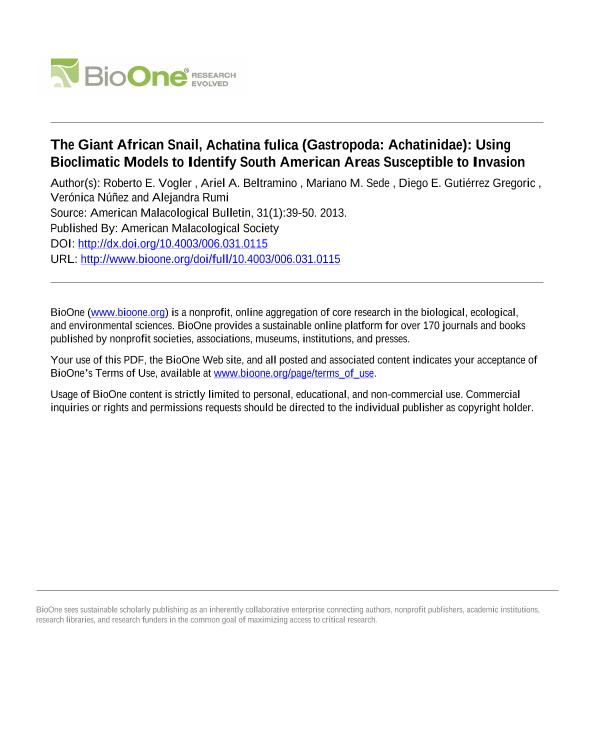Artículo
The giant African snail, Achatina fulica (Gastropoda: Achatinidae): Using bioclimatic models to identify South American areas susceptible to invasion
Vogler, Roberto Eugenio ; Beltramino, Ariel Anibal
; Beltramino, Ariel Anibal ; Sede, Mariano Miguel
; Sede, Mariano Miguel ; Gutierrez Gregoric, Diego Eduardo
; Gutierrez Gregoric, Diego Eduardo ; Nuñez, Maria Veronica
; Nuñez, Maria Veronica ; Rumi Macchi Z., Alejandra
; Rumi Macchi Z., Alejandra
 ; Beltramino, Ariel Anibal
; Beltramino, Ariel Anibal ; Sede, Mariano Miguel
; Sede, Mariano Miguel ; Gutierrez Gregoric, Diego Eduardo
; Gutierrez Gregoric, Diego Eduardo ; Nuñez, Maria Veronica
; Nuñez, Maria Veronica ; Rumi Macchi Z., Alejandra
; Rumi Macchi Z., Alejandra
Fecha de publicación:
02/2013
Editorial:
Amer Malacological Soc, Inc
Revista:
American Malacological Bulletin
ISSN:
0740-2783
e-ISSN:
2162-2698
Idioma:
Inglés
Tipo de recurso:
Artículo publicado
Resumen
The best way to reduce problems related to invasive species is by preventing introductions into potentially susceptible areas. The purpose of this study was to create distribution models for the invasive gastropod Achatina fulica Bowdich, 1822 in South America in order to evaluate its potential geographic distribution and identify areas at potential risk. This mollusc, considered one of the 100 world's worst invasive alien species, is the focus of intense concern due to its impact on agriculture, human health, and native fauna. We tested two commonly used ecological niche modeling methods: Genetic Algorithm for Rule-Set Prediction (GARP) and Maximum Entropy (MaxEnt). Models were run with occurrence points obtained from several sources, including the scientific literature, international databases, governmental reports and newspapers, WorldClim bioclimatic variables, and altitude. Models were evaluated with the threshold-independent Receiver Operating Characteristic (ROC) and Area Under the Curve (AUC). Both models had consistent performances with similar areas predicted as susceptible, including areas already affected and new potentially susceptible areas in both tropical and temperate regions of South America.
Palabras clave:
Land Mollusc
,
Bioinvasion
,
Distribution
,
Garp
,
Maxent
Archivos asociados
Licencia
Identificadores
Colecciones
Articulos(INBIRS)
Articulos de INSTITUTO DE INVESTIGACIONES BIOMEDICAS EN RETROVIRUS Y SIDA
Articulos de INSTITUTO DE INVESTIGACIONES BIOMEDICAS EN RETROVIRUS Y SIDA
Articulos(OCA HOUSSAY)
Articulos de OFICINA DE COORDINACION ADMINISTRATIVA HOUSSAY
Articulos de OFICINA DE COORDINACION ADMINISTRATIVA HOUSSAY
Citación
Vogler, Roberto Eugenio; Beltramino, Ariel Anibal; Sede, Mariano Miguel; Gutierrez Gregoric, Diego Eduardo; Nuñez, Maria Veronica; et al.; The giant African snail, Achatina fulica (Gastropoda: Achatinidae): Using bioclimatic models to identify South American areas susceptible to invasion; Amer Malacological Soc, Inc; American Malacological Bulletin; 31; 1; 2-2013; 39-50
Compartir
Altmétricas



